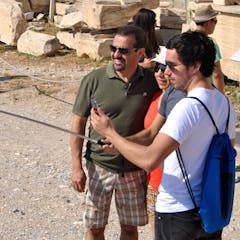
Articles on Selfies
Displaying 1 - 20 of 47 articles

We analysed hundreds of selfies and found some people were shamed more than others.

The expansion of social media and ubiquity of smartphone cameras has had a major impact on tourists’ behaviour.

It’s not always “worth it for the ‘gram”. People risk life, limb, and the environment for a selfie – and land managers can’t keep up.

When people see their friends behaving selfishly on holiday, they might assume they can do the same.

People have died taking selfies at cliffs, waterfalls and natural pools. We need to try a different approach to reducing the risk.

A meta-analysis of 437 studies found that egomaniacs aren’t just a bummer – they can be dangerous, too.

Selfie takers often choose to shoot the left side of their face, from above. But why exactly is that thought to make you look better?

The upcoming Galaxy Z Fold 2 is almost three-quarters screen. And while that’s convenient, it’s important to actually be able to hold the phone. As design evolves, how do manufacturers adapt?

Where once we subjected friends to post-holiday slideshows, now we share travel selfies live with a remote audience. This study teased out the tension between snapping and experiencing the trip.

Seeing wild animals can be the highlight of a holiday, and help pay for conservation efforts too, but we have to respect the animals.

A blue boat shed in Perth, Western Australia, shows the power of social media and the rise of unpaid influencers in marketing.

Software makers including Apple have been creating apps aimed at limiting how much time we spend using our smartphones. A behavioral scientist explains how – and whether – they work.

Taking selfie at disaster sites is so wrong at many levels. Not only it poses risks but the action also indicates mental issues

Calls to impose harsh prison sentences for verbal crimen injuria are often premised on the need to deter such behaviour.

Fields of sunflowers are now a common sight all over the world – but this has only been the case relatively recently.

As authorities crack down on selfies and social media, the underlying causes of conflict and potential to use social media to bring about positive social change are overlooked.

Here’s some advice on taking selfies with wild animals: don’t. It’s not fun for the animal, and can have serious knock-on effects for their health. And you could be injured (or worse).

Travelling will never be the same with the advances of communication technology. The recently opened theme park Rabbit Town shows this.

Technology has changed the way we travel. While social media can be a useful tourism tool, we need more education to ensure ‘selfie tourism’ doesn’t become the norm.

As former partner of TOWIE star Ferne McCann is sentenced for throwing acid in a nightclub, a criminologist considers the real reasons such attacks are on the rise.
